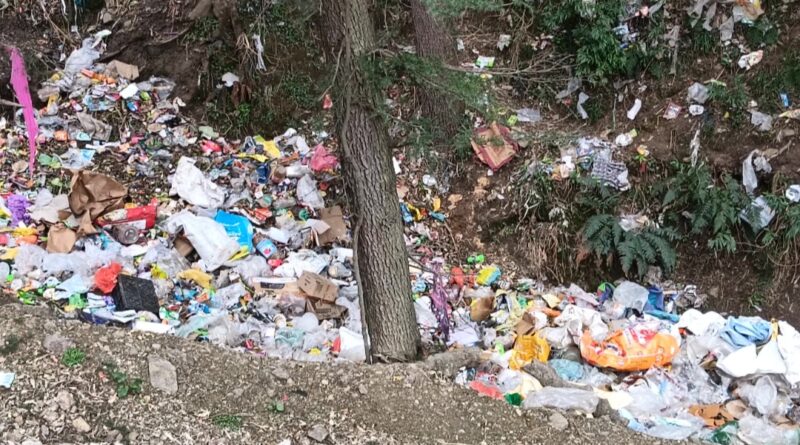Waste Crisis in the Himalayas: How Himachal’s Garbage is Exposing Deep-Rooted Environmental Injustice
Himachal Pradesh, known for its pristine mountains and cool climes, is now facing an alarming environmental crisis—not from rapid urbanisation or tourism alone, but from an overflowing mountain of garbage and bureaucratic indifference. Despite being one of India’s least urbanised states and having one of the lowest per capita waste generation rates, Himachal’s municipal solid waste (MSW) management is unraveling into a story of legal battles, land conflicts, and invisible communities suffering in silence.
A recent critical review by environmental researcher Manshi Asher in her research paper “CONTAMINATED LEGACIES A Critical Review of Himachal Pradesh’s Municipal Solid Waste Crisis and the Emerging Judicial Response” exposes how solid waste pollution in Himachal has become a symbol of deeper structural issues—ranging from judicial overreach and policy failure to environmental injustice and ignored community rights.
The Irony of a “Clean” Mountain State
With barely 10% of its population in urban areas, and a daily per capita waste output under 50 grams, Himachal seems unlikely to face a “garbage problem.” Yet visuals of plastic waste choking riversides and forests tell another story. Tourism, industrialisation, and a consumer-driven lifestyle are creating more non-biodegradable waste than ever before, especially in hotspots like Shimla, Manali, and Baddi.
The High Court and National Green Tribunal (NGT) have taken an active role in enforcing waste management rules, but their top-down approach has often ignored ground realities—especially in matters of land use and the rights of marginalised communities.
Bureaucracy vs Reality: The Ground Report
A 2021 audit by the CAG revealed that over 2.28 lakh metric tonnes of untreated waste was dumped across 16 urban local bodies. Much of this dumping was done illegally—near rivers, forests, and habitations.
The state’s waste strategy is largely inspired by corporate-led “Integrated Solid Waste Management” models, promoting large centralised facilities that often require diverting ecologically sensitive land. But this approach overlooks the Himalayan terrain’s fragility, scarcity of usable land, and the socio-ecological role of commons like pastures and riverbanks.
The Story of Suleman: A Fight for Justice from the Dump Yard
A particularly shocking case is that of Suleman, a Gujjar tribal pastoralist from Kenduwal in Baddi. After legally settling in the area and building his livelihood around livestock, he found himself living next to a growing dump site meant for solid waste from 40+ nearby settlements.
Despite glaring violations of environmental regulations—like proximity to the Sirsa River and no proper waste facility infrastructure—waste continued to pile up. Suleman, whose land was wrongly labeled as “encroached,” petitioned the High Court to relocate the site and compensate his family.
The court’s response? It directed authorities to make the dumping site “compliant,” largely sidestepping Suleman’s plea for relocation and recognition of his rights under the Forest Rights Act (FRA), 2006. Years later, the family still lives amid unbearable stench, legacy waste heaps, and blocked access routes.
The Courts and the “Compliance Trap”
Judicial monitoring, while seemingly proactive, has largely focused on infrastructure creation, waste segregation, and processing targets. But these court orders often overlook the underlying land conflicts, consent from gram sabhas, and environmental impact on marginalised groups.
In several cases, courts have even dismissed objections from Panchayats refusing to allow land transfers for waste sites, questioning their authority under FRA—a clear overreach that experts say weakens environmental rule of law.
Meanwhile, cities like Kullu and Manali have been penalised for unscientific dumping, while also being forced to accept waste from surrounding towns, stretching their already failing systems.
Technocratic Fixes, Real Failures
Himachal’s waste policy has increasingly leaned on controversial technologies like Waste to Energy (WTE) and Refuse-Derived Fuel (RDF) plants. The Manali RDF facility is a classic example—it processes less than half of the 50 tonnes of waste it receives daily, with untreated garbage contaminating the Beas River.
Still, such “tech fixes” continue to be promoted by courts and policy makers, despite being unsuitable for high-altitude, low-temperature environments where composting and waste processing are slower.
Environmental Injustice in the Himalayas
The Himachal experience is a textbook case of how environmental justice can be sidelined by bureaucracy and legalism. Peri-urban communities—often comprising Scheduled Tribes, landless Dalits, and pastoralists—are the worst affected, with no voice in decision-making or compensation mechanisms.
Commons such as pasture lands, traditionally shared and used sustainably, are now classified as forest or government land and repurposed for urban infrastructure without proper consultation. While the law mandates community consent under the FRA, courts and agencies have often bypassed or undermined these rights.
What Needs to Change?
This crisis is not just about garbage—it’s about governance, equity, and ecological wisdom. The way forward, as Manshi Asher argues, lies in:
- Recognising community rights over land and resources through proper implementation of the Forest Rights Act.
- Decentralising waste management tailored to mountain geographies, instead of replicating urban-industrial models.
- Strengthening Panchayati Raj institutions to enable local decision-making on land use.
- Shifting judicial focus from compliance checklists to redressal of environmental injustices.
- Reframing waste as a socio-ecological issue, not merely a technical problem.
Conclusion: Time to Clean Up More Than Just the Trash
Himachal’s solid waste crisis is not a story of incompetence alone—it’s about systemic neglect, elite environmentalism, and the invisibilisation of the poor in India’s ecological governance. As the courts demand “clean mountains,” the question remains: clean for whom, and at what cost?
Until justice is truly served—not just in courtrooms but on the ground—the mountains of Himachal will continue to bear the weight of both garbage and governance failure.



